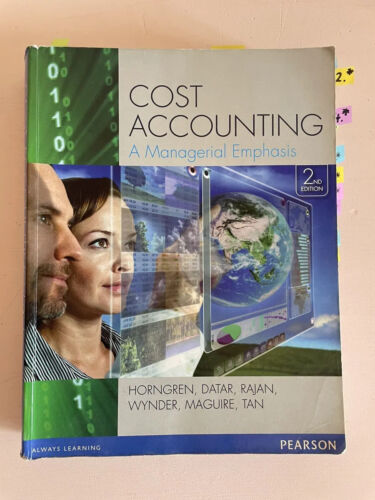=+3-41 KKK Purchasing Department cost drivers, simple regression analysis (Appendix 3-1) Fashion Flair operates a chain of
Question:
=+3-41 KKK Purchasing Department cost drivers, simple regression analysis (Appendix 3-1)
Fashion Flair operates a chain of 10 retail department stores. Each department store makes its own purchasing decisions. Barry Lee, assistant to the president of Fashion Flair, is interested in better understanding the drivers of Purchasing Department costs. For many years Fashion Flair has allocated Purchasing Department costs to products on the basis of the dollar value of inventory purchased.
A $100 item is allocated 10 times as many overhead costs associated with the Purchasing Department as a $10 item.
Barry recently attended a seminar titled ‘Cost drivers in the retail industry’. In a presentation at the seminar, Couture Fabrics, a leading competitor, reported number of purchase orders and number of suppliers to be the two most important cost drivers of Purchasing Department costs. The dollar value of inventory purchased in each purchase order was not found to be a significant cost driver. Barry interviewed several members of the Purchasing Department at the Fashion Flair store on the Gold Coast. They believed that Couture Fabrics’s conclusions also applied to their Purchasing Department.
Barry Lee collects the following data for the most recent year for Fashion Flair’s 10 retail department stores:
Department store Purchasing Department costs
(PDCs)
Dollar value of inventory purchased
(IP$)
Number of purchase orders
(no. of POs)
Number of suppliers
(no. of Ss)
Sydney $1 523 000 $68 315 000 4 357 132 Bondi 1 100 000 33 456 000 2 550 222 Canberra 547 000 121 160 000 1 433 11 Gold Coast 2 049 000 119 566 000 5 944 190 Perth 1 056 000 33 505 000 2 793 23 Hobart 529 000 29 854 000 1 327 33 Brisbane 1 538 000 102 875 000 7 586 104 Melbourne 1 754 000 38 674 000 3 617 119 Adelaide 1 612 000 139 312 000 1 707 208 Double Bay 1 257 000 130 944 000 4 731 201 Barry decides to use simple regression analysis to examine whether one or more of three variables (the last three columns in the table)
are cost drivers of Purchasing Department costs. Summary results for these regressions are as follows:
Regression 1: PDCs = a + (b × IP$)
Variable Coefficient Standard error t-Value Constant $1 039 061 $343 439 3.03 Independent variable 1: IP$ 0.0031 0.0037 0.84 r 2
= 0.08; Durbin–Watson statistic = 2.41 Regression 2: PDCs = a + (b × No. of POs)
Variable Coefficient Standard error t-Value Constant $730 716 $265 419 2.75 Independent variable 1: no. of POs $156.97 $64.69 2.43 r 2
= 0.42; Durbin–Watson statistic = 1.98 Regression 3: PDCs = a + (b × No. of Ss)
Variable Coefficient Standard error t-Value Constant $814 862 $247 821 3.29 Independent variable 1: no. of Ss $3 875 $1 697 2.28 r 2
= 0.39; Durbin–Watson statistic = 1.97 Required
Step by Step Answer:

Cost Accounting A Managerial Emphasis
ISBN: 9781442563377
2nd Edition
Authors: Monte Wynder, Madhav V. Rajan, Srikant M. Datar, Charles T. Horngren, William Maguire, Rebecca Tan





